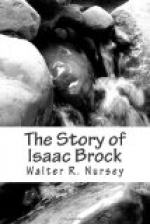Brock was at York when the news reached him. He at once sent part of the 41st to Niagara by lake, crossing himself with his brigade-major, Evans, and Macdonell and Glegg, his aides, and, as usual, in a batteau, with eleven men. At Fort George he bade adieu to some American officers, guests of the mess, and sent them across the river. He was eager to storm Fort Niagara, whose capture might have changed the entire situation, but alas! what of his instructions?
He called out more militia, though he had only a few tents and many of the men were drilling without shoes. One hundred Tuscaroras under Chief Brant answered his summons. He divided his augmented Niagara force into four divisions—at Fort Erie 400 men, at Fort Chippewa 300, at Queenston 300, at Fort George 500. Of these, 900 were militia.
The rattle of the matchlock was as familiar as cockcrow. Every man became in fact, if not in deed, a volunteer. If the musket was not strapped to the tail of the plough, it leaned against the snake-fence—loaded. The goose-step, the manual and platoon took the place of the quadrille. Every clearing became a drill-hall, every log cabin an armoury. Many of the militia were crack shots, with all the scouting instincts of the forest ranger. In the barrack-square, in scarlet, white and green, the regulars drilled and went through wondrous evolutions with clock-work precision—fighting machinery with the tenacity of the bull-dog, though lacking the craft of the woods that had taught the volunteer the value of shelter and the wisdom of dwelling on his aim.
Apart, stolid and silent, but interested spectators, lounged the dusky redmen, forever sucking at their pwoighun-ahsin (stone pipes) and making tobacco from the inner bark of red-willow wands, watching and wondering. The foot soldiers carried fire-locks, flints and cartridge boxes. These smooth-bore flint-locks had an effective range of less than 100 yards, and could be discharged only once a minute. Very different to the modern magazine rifle, which can discharge twenty-five shots in a minute and kill at 4,200 yards, while within 2,000 yards it is accurate and deadly. The mounted men were armed with sabres and ponderous pistols.
Our hero addressed the militia. The enemy, he told them, intended to lay waste the country. “Let them be taught,” he said, “that Canadians would never bow their necks to a foreign yoke.” As the custodian of their rights, he was trying to preserve all they held dear. He looked to them to repel the invaders.
Brock was placed in a most peculiar position, for while the passive Prevost was still instructing him—nearly three weeks after the declaration of war—“to take no offensive measures, as none would be taken by the United States Government,” General Hull, with a force of 2,500 tried soldiers, was on his way from Ohio through the Michigan forests to occupy Detroit and invade Canada. Hull reached Detroit, and




